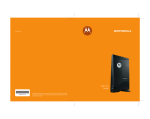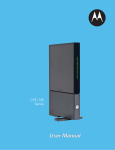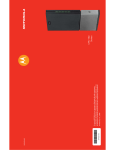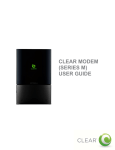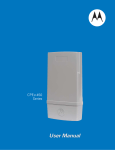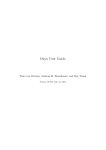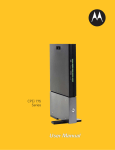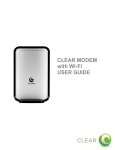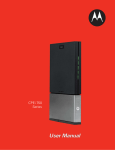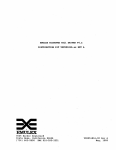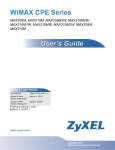Download Motorola CPEI 150 series User manual
Transcript
CPEi 150 Series User Manual Table of Contents Contents Chapter 1: Desktop CPEi150 User Guide Overview Information Overview . . . . . . . . . . . . . . . . . . . . . . . . . . . . . . . . . . . . . . . . . . . . . . . . . . . . . . . . . . . . . . . . . . . . . . . 1-2 Chapter 2: Installation Overview . . . . . . . . . . . . . . . . . . . . . . . . . . . . . . . . . . . . . . . . . . . . . . . . . . . . . . . . . . . . . . . . . . . . . . . 2-2 Chapter 3: Basic Configuration Overview . . . . . . . . . . . . . . . . . . . . . . . . . . . . . . . . . . . . . . . . . . . . . . . . . . . . . . . . . . . . . . . . . . . . . . . 3-2 Chapter 4: Advanced Configuration Overview . . . . . . . . . . . . . . . . . . . . . . . . . . . . . . . . . . . . . . . . . . . . . . . . . . . . . . . . . . . . . . . . . . . . . . . 4-2 Chapter 5: Configuring TCP/IP Overview . . . . . . . . . . . . . . . . . . . . . . . . . . . . . . . . . . . . . . . . . . . . . . . . . . . . . . . . . . . . . . . . . . . . . . . 5-2 Chapter 6: Troubleshooting Overview . . . . . . . . . . . . . . . . . . . . . . . . . . . . . . . . . . . . . . . . . . . . . . . . . . . . . . . . . . . . . . . . . . . . . . . 6-2 Chapter 7: Important Safety and Legal Information Important Safety and Legal Information . . . . . . . . . . . . . . . . . . . . . . . . . . . . . . . . . . . . . . . . . . . . . . 7-2 Caring for the Environment . . . . . . . . . . . . . . . . . . . . . . . . . . . . . . . . . . . . . . . . . . . . . . . . . . . . . . . . 7-4 CMM Disclosure . . . . . . . . . . . . . . . . . . . . . . . . . . . . . . . . . . . . . . . . . . . . . . . . . . . . . . . . . . . . . . . . . 7-5 Copyrights and Trademarks . . . . . . . . . . . . . . . . . . . . . . . . . . . . . . . . . . . . . . . . . . . . . . . . . . . . . . . . 7-6 68P09291A19-C APR 2009 i ii 68P09291A19-C APR 2009 Chapter 1 Chapter 1: Desktop CPEi150 User Guide Overview Information 68P09291A19-C APR 2009 1-1 1 Desktop CPEi150 User Guide Overview Information Overview Thank you for purchasing the Motorola CPE Indoor (CPEi) 150 desktop device. The Desktop CPE allows you to connect to the wireless world easily and seamlessly without complicated installation and setup procedures. The Desktop CPE device provides the user: • Convenience — with easy plug and play functionality. Flexible connectivity. Compact design. • Performance — dual integrated antennas, optimized for rich indoor multipath environments. Best in Class Radio Performance. Reliable indoor coverage. High throughput. • Control — remote management capability allows easy detection and authentication once the unit is setup. Robust security. Figure 1-1: CPEi150 Unit This product is subject to change. Not all features described in this WiMAX CPEi150 User’s Guide are available on all models. 1-2 68P09291A19-C APR 2009 Desktop CPEi150 User Guide Overview Information 1 For the most recent documentation, visit the Product Documentation page on www.motorola.com. Powerful Features in a Single Unit The CPE device provides the following features: • WiMAX Authentication • WAN DHCP Client • LAN DHCP Server • Router Functions • Firewall Protection • Port Forwarding Front of CPE The CPE unit contains an LED indicator at the top of the unit. The LEDs provide the status of the unit and signal strength for easy adjustment during setup. Table 1-1 LED Indicator Interface Item Description Power Status The LEDs are: • On - power to the CPE is on. • Off - power to the CPE is off. Initializing Status The center LED flashes when the CPE is initializing. Signal Strength • If all LEDs on the bar are lit, full signal is being received. • If all LEDs are off, the CPE is unplugged. • LEDs will display a chase pattern when the device is attempting to locate and connect to the network. NOTE There is no reset button on this CPE unit. If you want to reset the CPE, pull out the power cord and plug it in again. Side Panel The side panel of the unit contains the Ethernet Port, the Power Connection Port, and a Ethernet Port LED. 68P09291A19-C APR 2009 1-3 1 Desktop CPEi150 User Guide Overview Information Figure 1-2: CPEi150 Side Panel Table 1-2 Port Descriptions Side Panel Ports Description Ethernet Ethernet Port Power AC Power Connector Ethernet LED The LED is: • On - Ethernet Port is connected. • Off - Ethernet Port is not connected. • Blinking in 5-10 second intervals - the Ethernet cable is not connected to the computer. Operating Information Operating temperature for this unit is 0-40ºC (32-104ºF) AC Power Rating for this unit is: • 110 ~ 240 AC 1-4 68P09291A19-C APR 2009 Chapter 2 Chapter 2: Installation 68P09291A19-C APR 2009 2-1 2 Installation Overview To connect the CPEi150, you need to review the following sections: • • What’s in the box? Easy Setup What’s in the Box? Before you begin installation, check that you have received the following items with your CPE: Table 2-1 CPE Box Contents Item Description AC Adaptor Power Adaptor Power Cord Power cord that connects the AC Adaptor to the CPE Ethernet Cable Cable to connect the Ethernet port on your CPE to your PC or laptop computer ethernet port Quick Start Guide Guide to demonstrate the setup and basic IP configuration Easy Setup Perform the following tasks before attaching the power cord or powering up the unit: • Rotate the base of the CPE to be in a perpendicular position. • • • • • • Connect one end of the Ethernet cable to the Ethernet port of the CPE. Stand the CPE vertically on a flat surface. Connect the other end of the same Ethernet cable to an Ethernet port on your PC or laptop computer. Connect the power cord and the power adapter together. Plug the power adapter into an AC power outlet. The CPE will automatically turn on. Connect the power adapter to the power connector on the side of the unit. NOTE Do NOT mount the CPE unit horizontally and do NOT block the air ventilation holes at the top of the unit. 2-2 68P09291A19-C APR 2009 Installation 2 Before You Begin Configuration Some settings on your computer must be verified or changed to ensure that your computer configuration can support the Desktop CPE. • • • Call your service provider to confirm that your service provider has registered your unit. Verify that the IP address and DNS settings are automatically generated in your Local Area connection of your Internet Protocol (TCP/IP) properties. Refer to the chapter titled “Configuring TCP/IP” for information on how to do this. Ensure you know which protocol you will need to enter in the Setup Wizard procedure. This will either be EAP-TLS or EAP-TTLS. If EAP-TTLS is to be used, your service provider will provide you a Username and Password. User Interface Overview A web based Graphical User Interface (GUI) is used to configure the features of the CPE. Figure 2-1: Main Menu Sample 68P09291A19-C APR 2009 2-3 2 Installation There are six main menus in the GUI: Table 2-2 Menu Description Menu Tab Description Personalize Use this menu to set up your password, device time and device name. You can also abandon your personal settings by clicking “Restore Factory Settings”. Internet Use this menu to configure internet connection settings, including Authentication, Protocol, Firewall, and Dynamic DSN. Status Use this menu to display network status, including WiMAX, Internet, LAN, and Device Information. Port Forwarding Use this menu to enable Universal Plug and Play (UPnP) Internet Gateway Device (IGD) profile to allow certain Windows applications to setup the port forwarding rule dynamically when NAT is enabled on this device. Local Address Use this menu to display the IP Address and netmask address in the local network. Control Panel Use this menu to manage the device software. The following buttons appear at the bottom of each configuration page: Table 2-3 Button Descriptions 2-4 Button Function Apply Saves your changes. If you restart your CPE without saving your changes, all changes are lost. After the device restarts, the last saved configuration is used. Undo Clears your changes on the current page and returns to the main menu. Once you click Apply, the Undo button will NOT clear your changes. Next Confirms the current setting and moves on to the next screen. Refresh Manually updates current status page. Auto Refresh Updates automatically without needing you to refresh manually. Wizard Starts Setup Wizard manually if your CPE did not run the setup program automatically. 68P09291A19-C APR 2009 Installation 2 NOTE Illustrations in this manual containing an image of what you see on your computer screen are for reference purposes only. Values shown in the illustrations in this manual may be different from what you see on your computer screen. Logging In to the CPE Use the following procedure to log into the Desktop CPE: 1. On a computer that is connected to the CPE, open a web browser. Enter the IP address: http://192.168.15.1 into Address field in order to gain access to your CPE. If you cannot access the CPE, refer to the chapter titled: Configuring TCP/IP for more information. NOTE Or in the Address or Location field, type http://mywimax. and press ENTER to display the login screen. You must include the period (.) after http://mywimax. in order to access the login screen. 2. 3. 4. 5. 6. The Welcome to Motorola WiMAX CPE screen will be displayed and will prompt you for a password. In the Password field, type the password (default is motorola). Click Login. First time users will see a pop-up box that states: “The Wizard application will guide you through for the first time configuration. Click OK button to continue.” Click the OK button to launch the wizard application. Setup Wizard and Authentication Step 1 - Change Password Once you have launched the setup wizard, you will be prompted to change your password. Motorola recommends using a password to protect your home network and CPE device. Passwords are case-sensitive. To change your password: • Ensure the “Enable Login Password Protection” box is checked. • Enter a New Login Password in the box. Passwords can be no more than 20 characters in length. • Re-type your new password in the Confirm New Login Password box. • Click Next. 68P09291A19-C APR 2009 2-5 2 Installation Step 2 - Device Time This screen allows you to set the time zone and to enable Daylight Savings Time (when applicable) for your location. • Select the appropriate time zone for your location from the drop down box. • Check the box called “Auto Adjust for Daylight Savings Time” if you live in a region that observes Daylight Savings Time (this box is checked by default). • Click Next. Step 3 - WiMAX Security The WiMAX Security tab will contain your authentication method. Check with your service provider to determine if they require a user name and password for authentication purposes. • If the Authentication Method is EAP-TLS: - Enter the Realm information supplied by your service provider. - Click the Apply button when finished. • If the Authentication Method is EAP-TTLS/MS-CHAPv2: - Enter the User name and Password as supplied by your service provider. - Enter the Realm information as provided by your service provider. - Click the Apply button when finished. Congratulations! You have now completed the setup of your WiMAX connection. Click OK on the Congratulations! dialog box. A status screen will appear showing Network status. When your CPE successfully connects to the Internet, you will see the actual link status and statistics. Note that the screen shown in this illustration is an example of the screen. Use the scroll bar on your menu screen to view all the status items that are reported by your unit. Figure 2-2: Status Screen 2-6 68P09291A19-C APR 2009 Chapter 3 Chapter 3: Basic Configuration 68P09291A19-C APR 2009 3-1 3 Basic Configuration Overview Once the CPE setup has been completed, you can login to your CPE from any computer on your home network by typing the device name in the address bar. The default device name is mywimax. or 192.168.15.1 This section describes the PERSONALIZE, INTERNET, and STATUS Menus that are available. Personalize Menu The Personalize menu provides the following tabs: • Password • Device Time • Device Name • Restore Factory Settings Figure 3-1: Personalize Menu Password Tab The password tab allows you to enable/disable password protection. You can also change your password here. Be sure to click the Apply button when finished. Table 3-1 Password Tab Fields 3-2 Field or Button Description Enable Login Password Protection Checking this box will require login Password Protection. 68P09291A19-C APR 2009 Basic Configuration 3 Table 3-1 Password Tab Fields Field or Button Description New Login Password Enter your new password here. Maximum 20 characters. Passwords are casesensitive. Confirm New Login Password Re-enter your new password here, exactly as entered above. Device Time Tab The Device Time tab allows you to establish the time zone for your location. It also allows you to automatically adjust for Daylight Savings Time if necessary. Be sure to click the Apply button when finished. Table 3-2 Device Time Tab Fields Field or Button Description Current Local Time Shows the current local date and time. Tim e Zone Select your local time zone from the drop down box. Auto Adjust for Daylight Saving Time Check this box if your location observes Daylight Savings Time. (Default is checked) Device Name Tab The Device Name tab allows you to rename your CPE device. This is the Device Name you enter on an internet browser address bar to access your CPE device. Be sure to click the Apply button when finished. Table 3-3 Device Name Tab Fields Field or Button Description New Device Name Enter the new name for the CPE device. Maximum 20 characters. Restore Factory Settings Tab Table 3-4 Restore Factory Settings Tab Fields 68P09291A19-C APR 2009 Field or Button Description Restore Factory Settings Checking this box will restore the CPE to factory default settings. The device will restart when you click Apply. 3-3 3 Basic Configuration Internet Menu The Internet menu provides the following tabs: • WiMAX Security • Internet Protocol Tab • Firewall • Dynamic DNS Figure 3-2: Internet Menu Screen WiMAX Security Tab The WiMAX Security tab will contain your authentication method. Check with your service provider to determine if they require a user name and password for authentication purposes. Table 3-5 WiMAX Tab Fields Field or Button Description Authentication Method Drop down box allows you to select either EAP-TLS (default) or EAP-TTLS/MSCHAPv2. User Name (EAP-TTLS/MS-CHAPv2 only) Enter the User Name supplied by your service provider. Password (EAP-TTLS/MS-CHAPv2 only) Enter the Password supplied by your service provider. Realm Supplied by your service provider. If your authentication method is EAP-TLS, then a User Name and Password are not necessary. Click the Apply button. 3-4 68P09291A19-C APR 2009 Basic Configuration 3 Internet Protocol Tab Please check with your service provider for these settings. If you are unsure of the settings, leave the default values set and click the Apply button. If your service provider has instructed you to change any of these settings, be sure to click the Apply button when you are finished. Firewall Tab A firewall helps to protect your home network from unauthorized access. It will also help to manage authorized access from the internet to your CPE. Table 3-6 Firewall Tab Fields Field or Button Description Enable Firewall Check this box to enable the firewall for your home network. Enable Web Login from Internet (Grayed out if Enable Firewall is not selected). Checking this box enables you to access your CPE device from a network other than your own. Web Login Port from Internet Choose a port number to connect to when logging in from a network other than your own. The default is 8080. Enable ping from Internet Enables the CPE to respond to a ping from the Internet. This option would be enabled to allow testing only. Do not leave this enabled. The Enable Web Login from Internet and the Enable Ping from Internet options are by default turned off. This is because these options allow unknown users to access your computer via the internet, and this is not safe. You may need to turn these options on if there is a problem with your CPE/Internet Connection. Turning these options on will allow your service provider access to your computer to troubleshoot any problems. Remember to enter the number of the port that is allowed to access your computer if these options are turned on. Be sure to click the Apply button once you are finished. Dynamic DNS Tab Dynamic Domain Name Service (DDNS) allows a user with a non-static IP address to keep their domain name associated with an ever changing IP address. As an example, DDNS is used when you are hosting your own website. 68P09291A19-C APR 2009 3-5 3 Basic Configuration Table 3-7 Dynamic DNS Tab Fields Field or Button Description Enable DDNS Check this box to Enable DDNS (default is unchecked). DDNS Service Provider Select DDNS Service Provider that you belong to from the drop down box. Be sure to click the Apply button once you are finished. Status Menu The Status menu provides the following tab: • Network Figure 3-3: Status Menu Screen Network Tab The Network tab will provide any status associated with your WiMAX Wireless Broadband connection. 3-6 68P09291A19-C APR 2009 Chapter 4 Chapter 4: Advanced Configuration 68P09291A19-C APR 2009 4-1 4 Advanced Configuration Overview The Advanced Configuration section describes the following menus: • Port Forwarding • Local Address • Control Panel Port Forwarding Menu Port forwarding enables you to direct incoming traffic to specific LAN hosts (computers on your network) based on the protocol and port number. It is used to play Internet games or provide local services (such as web hosting) for a LAN group. The Port Forwarding menu provides the following tabs: • Basic • Forwarding Figure 4-1: Port Forwarding Menu Screen Basic Tab Table 4-1 Port Forwarding Basic Tab Fields Field or Button Enable UPnP IGD DMZ (DeMilitarized Zone) IP Address 4-2 Description Enables Universal Plug and Play (UPnP) Internet Gateway Device (IGD) profile to allow certain Windows applications to setup the port forwarding rule dynamically when NAT is enabled on this device. Enter the DMZ IP Address. 68P09291A19-C APR 2009 Advanced Configuration 4 Be sure to click the Apply button once you have made changes. Forwarding Tab Click on the ADD button to create additional Port Forwarding rules. Table 4-2 Port Forwarding Tab Fields Field or Button Description Select Select a box when you want to delete the specific row. Protocol Select TCP (Transmission Control Protocol) or UDP (User Datagram Protocol). WAN Port Start Enter the beginning port range for external network access. WAN Port End Enter the ending port range for external network access. LAN IP Address Enter the IP address to host the service in the dotted-decimal format. LAN Port Start Enter the beginning port range for internal network access. LAN Port End Enter the ending port range for internal network access. Enabled Check to enable specific port forwarding. Be sure to click the Apply button once you have made changes. Local Address Menu The Local Address menu allows you to configure your Local Area Network (LAN) connections. The Local Address menu provides the following tabs: • DHCP Server • Lease Status • Lease Reservation 68P09291A19-C APR 2009 4-3 4 Advanced Configuration Figure 4-2: Local Address Menu Screen DHCP Server Tab The DHCP Server tab enables Dynamic Host Configuration Protocol (DHCP) server functionality on the LAN, allowing the router to dynamically assign lease IP addresses to clients that connect to it from the local network. Table 4-3 DHCP Server Tab Fields 4-4 Field or Button Description Enable DHCP Server If selected, the DHCP server on the gateway assigns IP addresses to the computers and other hosts on your network if they have DHCP enabled. By default, the gateway server is enabled. If there is another DHCP server running on your network (on another router), you must disable one of the DHCP servers. If not selected, you must carefully configure the IP address, Subnet Mask, and DNS settings of every host on your network. Do not assign the same IP address to more than one host. Your gateway must be on the same subnet as the other hosts. DHCP Server IP Address Enter the default port forwarding LAN Client IP Address. 68P09291A19-C APR 2009 Advanced Configuration 4 Table 4-3 DHCP Server Tab Fields Field or Button Description DHCP Starting IP Address Sets the first IP address assigned by the DHCP server, in dotted-decimal format. It must be greater than the IP address value of the gateway. For example, if the IP address of the gateway is 192.168.15.1 (default), the starting IP address must be 192.168.15.2 (or higher). DHCP Ending IP Address Sets the final IP address assigned by the DHCP server. If the DHCP server runs out of DHCP addresses, users cannot access network resources. If this happens, increase the Ending IP (to the limit of 254) or reduce the Lease Time. DHCP Lease Time Sets the time, in seconds, that a network computer remains connected to the gateway using its current assigned IP address. At the end of this time, the DHCP server renews the lease or assigns the computer a new IP address. The default is 1 hour. The maximum is about 278 hours. Be sure to click the Apply button once you have made changes. Lease Status Tab The Lease Status tab in the Local Address menu displays the active DHCP leases since the last reboot. Table 4-4 Lease Status Tab Fields Field or Button Description Client Host Name Displays the client host name. The Name field is limited to 20 characters (only 5 appear in display). MAC Address Media Access Control (MAC) address. IP Address Shows the IP Address for each active lease. Remaining Lease Duration Shows the amount of time, in seconds, remaining in the lease. Be sure to click the Apply button once you have made changes. Lease Reservation Tab This tab allows you to manage the lease reservation so that the same client receives the same IP address each time. 68P09291A19-C APR 2009 4-5 4 Advanced Configuration Table 4-5 Lease Reservation Tab Fields Field or Button Description Select Select this box if you want to delete an established lease reservation. Be sure to click the Delete button once you have selected your exception to be deleted. Client Host Name Enter the client host name. The Name field is limited to 20 characters (only 5 appear in display). MAC Address Media Access Control (MAC) address. Enter the MAC address of the device. IP Address Enter the IP address that you want assigned to the MAC Address. Enabled Checking this box enables the lease reservation. Click on the Add button to create an additional Lease Reservations. To delete a Lease Reservation, select the reservation to be removed and click the Delete button. Be sure to click the Apply button once you have made changes. Control Panel Menu The Control Panel section allows you to view/update your software information. The Control menu provides the following tabs: • Software • Certificate • System • About 4-6 68P09291A19-C APR 2009 Advanced Configuration 4 Figure 4-3: Control Panel Menu Screen Software Tab The Software tab manages the software on your CPE device. It is also where you can upgrade device software. Table 4-6 Software Tab Fields Field or Button Description Browse Use this button to browse your computer for additional software packages. Upgrade Once you have located the software package/update you would like to add to your device. View Use this button if you are unable to see the Available Software List. Install Click this button to begin installation of the software you have selected. Unins tal l Click this button to uninstall a selected software package. Certificate Tab The Certificate tab is where you manage the certificates that are stored on the device. 68P09291A19-C APR 2009 4-7 4 Advanced Configuration Table 4-7 Certificate Tab Fields Field or Button Description Browse Use this button to locate a certificate file on your computer. Import Click this button to install a certificate once you have located the certificate file on your computer. Remove Click this button to remove a selected certificate. System Tab This tab allows you to manage additional features of your CPE device. Table 4-8 System Tab Fields Field or Button Description Language Used in User Interface Select the desired language for the user interface. The default language is English. Enable WiMAX Radio Interface Check this box to enable the WiMAX Radio Interface. Auto Refresh Interval Enter, in seconds, the interval for status Auto Refresh. Valid range is 10 seconds 60 seconds. The default value is 10 seconds. Rebootstrap EMS Check this box to reconnect the device with the EMS. NOTE: Only perform this function under the supervision of a Customer Support Representative. Be sure to click the Apply button once you have made changes. About Tab The About Tab will display basic properties of your CPE device such as: Part Number, Model ID, Hardware Version, Serial Number and the WiMAX MAC Address. 4-8 68P09291A19-C APR 2009 Chapter 5 Chapter 5: Configuring TCP/IP 68P09291A19-C APR 2009 5-1 5 Configuring TCP/IP Overview This section contains two examples of configuring TCP/IP in a Windows environment. Most computers already have the TCP/IP configuration enabled. Use the following procedures to verify that the configuration is set up. All client computers on your network must be configured for TCP/IP (the protocol that controls communication among computers). We have provided two examples for you in the following examples: • Configuring TCP/IP in Windows 2000 • Configuring TCP/IP in Windows XP NOTE Follow the instructions in your computer user manual for other Operating Systems. Configuring TCP/IP in Windows 2000 1. 2. On the Windows Desktop, click Start. Select Settings and then Control Panel from the pop-up menus to display the Control Panel window: Figure 5-1: Windows Control Panel 3. 5-2 Double-click the Network and Dial-up Connections icon to display the Network and Dial-up Connections window: 68P09291A19-C APR 2009 Configuring TCP/IP 5 Figure 5-2: Network and Dial-Up Connections 4. Click Local Area Connection number icon. The value of number varies from system to system. The Local Area Connection number Status window is displayed: Figure 5-3: Local Area Connection 5. Click Properties. Information similar to the following window is displayed: Figure 5-4: Properties 68P09291A19-C APR 2009 5-3 5 Configuring TCP/IP 6. If Internet Protocol (TCP/IP) is in the list of components, TCP/IP is installed. You can skip to Step 10. If Internet Protocol (TCP/IP) is not in the list, click Install. The Select Network Component Type window is displayed: Figure 5-5: Select Network Connection Type 7. Click Protocol on the Select Network Component Type window and click Add. The Select Network Protocol window is displayed: Figure 5-6: Select Network Protocol NOTE You may have to use the scroll bar to locate the Internet Protocol (TCP/IP) setting. 8. 9. 10. 11. 5-4 Click Internet Protocol (TCP/IP). Click OK. The Local Area Connection number Properties window is re-displayed. Be sure the box next to Internet Protocol (TCP/IP) is checked. Click Properties. The Internet Protocol (TCP/IP) Properties window is displayed: 68P09291A19-C APR 2009 Configuring TCP/IP 5 Figure 5-7: Internet Protocol (TCP/IP) Properties 12. Be sure Obtain IP address automatically and Obtain DNS server address automatically are selected. 13. Click OK to accept the TCP/IP settings. 14. Click Close to close the Local Area Connection number Properties window. 15. Click OK. 16. If prompted to restart the computer and click OK again. Configuring TCP/IP in Windows XP 1. 68P09291A19-C APR 2009 On the Windows desktop, click Start to display the Start window: 5-5 5 Configuring TCP/IP Figure 5-8: Windows XP Start Window (223.50) 2. Click Control Panel to display the Control Panel window. The display varies, depending on your Windows XP view options. If the display is a Category view as shown below, continue with Step 3. Otherwise, skip to Step 5. Figure 5-9: Control Panel (223.50) 3. 5-6 Click Network and Internet Connections to display the Network and Internet Connections window: 68P09291A19-C APR 2009 Configuring TCP/IP 5 Figure 5-10: Network and Internet Connections 4. 5. Click Network Connections. Skip to Step 6. If a classic view similar to below is displayed, double-click Network Connections to display the LAN or High-speed Internet connections. Figure 5-11: Control Panel Classic View 6. 68P09291A19-C APR 2009 Right-click the Local Area Connection. If more than one connection is displayed, be sure to select the one for your network interface. 5-7 5 Configuring TCP/IP Figure 5-12: Network Connections 7. Select Properties from the pop-up menu to display the Local Area Connection Properties window: Figure 5-13: Local Area Connection Properties 8. 9. 5-8 On the Local Area Connection Properties window, select Internet Protocol (TCP/ IP) if it is not selected. Click Properties to display the Internet Protocol (TCP/IP) Properties window: 68P09291A19-C APR 2009 Configuring TCP/IP 5 Figure 5-14: Internet Protocol (TCP/IP) Properties • • 68P09291A19-C APR 2009 Be sure to Obtain IP address automatically and Obtain DNS server address automatically are selected. Click OK to close the TCP/IP Properties window. 5-9 5 5-10 Configuring TCP/IP 68P09291A19-C APR 2009 Chapter 6 Chapter 6: Troubleshooting 68P09291A19-C APR 2009 6-1 6 Troubleshooting Overview This chapter provides basic troubleshooting procedures for your CPEi150 device. LED indicators are Off • Check that the AC power adapter is properly plugged into the electrical outlet and into the Desktop CPE. A Computer Cannot Log On to the CPE Check that the Ethernet cable is properly connected to the Desktop CPE unit and the computer. Cannot Connect to the Internet • • • Check the Desktop CPE connection status from the Web Interface, refer to the Connection Status section to verify the connection status. If the Desktop CPE connection is down, and the gateway has not received an IP for more than 5 minutes, re-run the set up wizard. To restart the CPE, unplug the power and re-connect. Additional Troubleshooting Help Contact your service provider for additional help. 6-2 68P09291A19-C APR 2009 Chapter 7 Chapter 7: Important Safety and Legal Information 68P09291A19-C APR 2009 7-1 7 Important Safety and Legal Information Important Safety and Legal Information Your Motorola WiMAX Wireless Broadband Gateway is designed and tested to comply with a number of national and international standards and guidelines (listed below) regarding human exposure to RF electromagnetic energy. This product complies with the following RF energy exposure standards and guidelines: • United States Federal Communications Commission, Code of Federal Regulations; 47CFR part 2 sub-part J • American National Standards Institute (ANSI)/ Institute of Electrical and Electronic Engineers (IEEE) C95 1-2005 • Institute of Electrical and Electronic Engineers (IEEE) C95.1-1999 Edition • International Commission on Non-Ionizing Radiation Protection (ICNIRP) 1998 • Ministry of Health (Canada) Safety Code 6. Limits of Human Exposure to Radio frequency Electromagnetic Fields in the Frequency Range from 3 kHz to 300 GHz, 1999 RF Exposure Compliance and Guidelines Operating Instructions To comply with FCC RF energy exposure requirements, this Gateway desktop transmitter should be operated at a minimum separation distance of 20 cm from all persons. For additional information on exposure requirements or other training information, visit http://www. motorola.com/rfhealth FCC Regulatory Information This device complies with Part 15 of the FCC Rules. Operation is subject to the following two conditions: (1) this device may not cause harmful interference, and (2) this device must accept any interference received; including interference that may cause undesired operation. This equipment has been tested and found to comply with the limits for a Class B digital device pursuant to Part 15 of the FCC rules. These limits are designed to provide reasonable protection against harmful interference in a residential installation. This equipment generates, uses, and can radiate radio frequency energy and, if not installed and used in accordance with the instructions, may cause harmful interference to radio communications. However, there is no guarantee that interference will not occur in a particular installation. If this equipment does cause harmful interference to radio or television reception, which can be determined by turning the equipment off and on, the user is encouraged to try to correct the interference by one of the following measures: • Reorient or relocate the receiving antenna. • Increase the separation between the equipment and receiver. • Connect the equipment into an outlet on a circuit different from that to which the receiver is connected. • Consult the dealer or an experienced radio/TV technician for help. This Gateway desktop transmitter must not be co-located or operating in conjunction with any other antenna or transmitter. FCC Caution: Any changes or modifications not expressly approved by the party responsible for compliance could void the user's authority to operate this equipment. 7-2 68P09291A19-C APR 2009 Important Safety and Legal Information 7 Industry Canada Statement This device complies with RSS-193, and RSS-Gen of the Industry Canada Rules. Operation is subject to the following two conditions: this device may not cause interference and this device must accept any interference, including interference that may cause undesired operation of the device This device has been designed to operate with an antenna having a maximum gain of 7 dBi. Antenna having a higher gain is strictly prohibited per regulations of Industry Canada. The required antenna impedance is 50 ohms. To reduce potential radio interference to other users, the antenna type and its gain should be so chosen that the equivalent isotropically radiated power (e.i.r.p) is not more than that permitted for successful communications. This Class B digital apparatus complies with Canadian ICES-003. Cet appareil numérique de la classe B est conforme à la norme NMB-003 du Canada. IC Radiation Exposure Statement: NOTE This equipment complies with IC radiation exposure limits set forth for an uncontrolled environment. This equipment should be installed and operated with minimum distance 20cm between the radiator & your body. 68P09291A19-C APR 2009 7-3 7 Important Safety and Legal Information Caring for the Environment The following information is provided to enable regulatory compliance with the European Union (EU) Directive 2002/96/EC Waste Electrical and Electronic Equipment (WEEE) when using Motorola Networks equipment in EU countries. Disposal of Motorola Equipment in EU Countries This product is compliant with the requirements of the European Union Restriction of Hazardous Substances (EU RoHS) directive. Please do not dispose of Motorola Networks equipment in landfill sites. In the EU, Motorola Networks in conjunction with a recycling partner will ensure that equipment is collected and recycled according to the requirements of EU environmental law. Disposal of Motorola Equipment in Non-EU Countries In non-EU countries, dispose of Motorola Networks equipment in accordance with national and regional regulations. 7-4 68P09291A19-C APR 2009 Important Safety and Legal Information 7 CMM Disclosure The China Management Methods (CMM) Disclosure Table is intended only to communicate compliance with China requirements; it is not intended to communicate compliance with EU RoHS or any other environmental requirements. Figure 7-1: CMM Disclosure Information 68P09291A19-C APR 2009 7-5 7 Important Safety and Legal Information Copyrights and Trademarks Notice While reasonable efforts have been made to assure the accuracy of this document, Motorola, Inc. assumes no liability resulting from any inaccuracies or omissions in this document, or from use of the information obtained herein. The information in this document has been carefully checked and is believed to be entirely reliable. However, no responsibility is assumed for inaccuracies or omissions. Motorola, Inc. reserves the right to make changes to any products described herein and reserves the right to revise this document and to make changes from time to time in content hereof with no obligation to notify any person of revisions or changes. Motorola, Inc. does not assume any liability arising out of the application or use of any product, software, or circuit described herein; neither does it convey license under its patent rights or the rights of others. It is possible that this publication may contain references to, or information about Motorola products (machines and programs), programming, or services that are not announced in your country. Such references or information must not be construed to mean that Motorola intends to announce such Motorola products, programming, or services in your country. Copyrights This instruction manual, and the Motorola products described in this instruction manual may be, include or describe copyrighted Motorola material, such as computer programs stored in semiconductor memories or other media. Laws in the United States and other countries preserve for Motorola and its licensors certain exclusive rights for copyrighted material, including the exclusive right to copy, reproduce in any form, distribute and make derivative works of the copyrighted material. Accordingly, any copyrighted material of Motorola and its licensors contained herein or in the Motorola products described in this instruction manual may not be copied, reproduced, distributed, merged or modified in any manner without the express written permission of Motorola. Furthermore, the purchase of Motorola products shall not be deemed to grant either directly or by implication, estoppel, or otherwise, any license under the copyrights, patents or patent applications of Motorola, as arises by operation of law in the sale of a product. Usage and Disclosure Restrictions License Agreements The software described in this document is the property of Motorola, Inc and its licensors. It is furnished by express license agreement only and may be used only in accordance with the terms of such an agreement. Copyrighted Materials Software and documentation are copyrighted materials. Making unauthorized copies is prohibited by law. No part of the software or documentation may be reproduced, transmitted, transcribed, stored in a retrieval system, or translated into any language or computer language, in any form or by any means, without prior written permission of Motorola, Inc. 7-6 68P09291A19-C APR 2009 Important Safety and Legal Information 7 High Risk Materials Components, units, or third-party products used in the product described herein are NOT fault-tolerant and are NOT designed, manufactured, or intended for use as online control equipment in the following hazardous environments requiring fail-safe controls: the operation of Nuclear Facilities, Aircraft Navigation or Aircraft Communication Systems, Air Traffic Control, Life Support, or Weapons Systems (High Risk Activities). Motorola and its supplier(s) specifically disclaim any expressed or implied warranty of fitness for such High Risk Activities. Trademarks MOTOROLA and the Stylized M Logo are registered in the US Patent & Trademark Office. All other product or service names are the property of their respective owners. © 2009 Motorola, Inc. 68P09291A19-C APR 2009 7-7 7 7-8 Important Safety and Legal Information 68P09291A19-C APR 2009 MOTOROLA and the Stylized M Logo are registered in the US Patent & Trademark Office. All other product or service names are the property of their respective owners. © 2009 Motorola, Inc.
















































